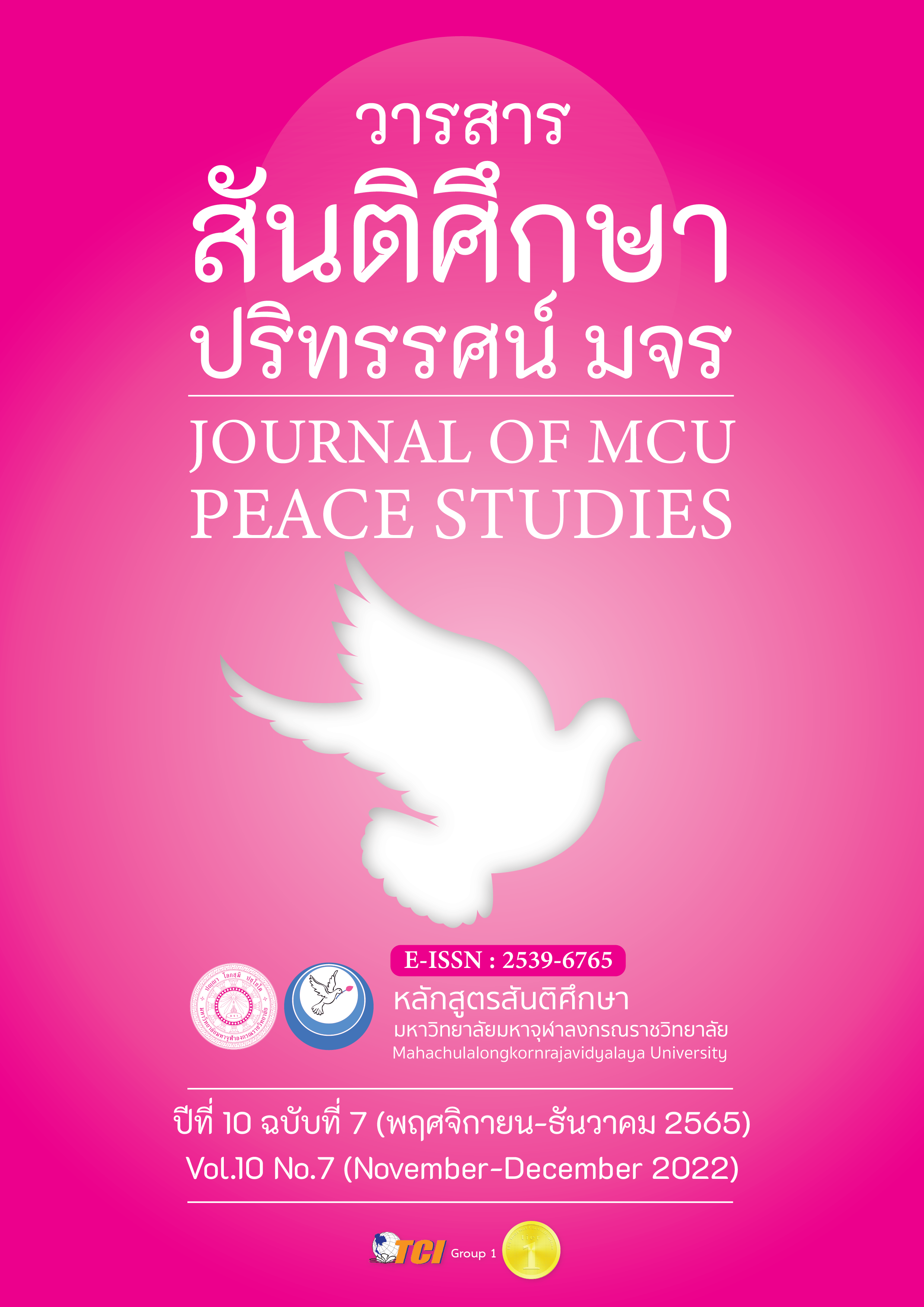รูปแบบการพัฒนาทักษะกระบวนการคิดขั้นสูงสำหรับนักศึกษาครู
Main Article Content
บทคัดย่อ
การวิจัยมีวัตถุประสงค์เพื่อ 1. สร้างรูปแบบการพัฒนาทักษะกระบวนการคิดขั้นสูงสำหรับนักศึกษาครู 2. ศึกษาผลการใช้รูปแบบการพัฒนาทักษะกระบวนการคิดขั้นสูงสำหรับนักศึกษาครู 3. ประเมินความพึงพอใจที่มีต่อการจัดการเรียนรู้ตามรูปแบบการพัฒนาทักษะกระบวนการคิดขั้นสูงสำหรับนักศึกษาครู และ 4. ศึกษาผลการเขียนแผนการจัดการเรียนรู้ตามรูปแบบการพัฒนาทักษะกระบวนการคิดขั้นสูงสำหรับนักศึกษาครู กลุ่มตัวอย่างที่ใช้ในการวิจัยมี 2 กลุ่ม คือ 1. นักศึกษาคณะครุศาสตร์ มหาวิทยาลัย ราชภัฏเลย จำนวน 30 คน ได้มาโดยการสุ่มแบบกลุ่มและ 2. นักศึกษาคณะครุศาสตร์ มหาวิทยาลัยราชภัฏเลย จำนวน 28 คน ได้มาโดยการเลือกแบบเจาะจง เครื่องมือที่ใช้ในการวิจัย คือ 1. แบบประเมินความเหมาะสมรูปแบบมีค่า IOC อยู่ระหว่าง 0.80 - 1.00 และค่า α = 0.87, 2. แบบวัดทักษะกระบวนการคิดขั้นสูง 4 ฉบับ ทุกฉบับมีค่า IOC อยู่ระหว่าง 0.80 - 1.00 โดยแบบวัดทักษะกระบวนการคิดวิจารณญาณมีค่า p อยู่ระหว่าง 0.27 - 0.80, ค่า r อยู่ระหว่าง 0.40 - 0.93 และค่า α = 0.94, แบบวัดทักษะกระบวนการคิดตัดสินใจมีค่า p อยู่ระหว่าง 0.33 - 0.80, ค่า r อยู่ระหว่าง 0.33 - 0.93 และค่า α = 0.87, แบบวัดทักษะกระบวนการคิดสร้างสรรค์มีค่า r x y = 0.83 และแบบวัดทักษะกระบวนการคิดแก้ไขปัญหามีค่า p อยู่ระหว่าง 0.33 - 0.80, ค่า r อยู่ระหว่าง 0.40 - 0.80 และค่า α = 0.91, 3. แบบประเมินความพึงพอใจที่มีต่อการจัดการเรียนรู้ตามรูปแบบมีค่า IOC อยู่ระหว่าง 0.80 - 1.00 และค่า α = 0.88 และ 4. แบบประเมินแผนการจัดการเรียนรู้ตามรูปแบบมีค่า IOC อยู่ระหว่าง 0.80 - 1.00 และค่า α = 0.88 วิเคราะห์ข้อมูลโดยหาค่า , S.D. และ t - test (Dependent Sample)
ผลการวิจัยพบว่า 1. รูปแบบการพัฒนาทักษะกระบวนการคิดขั้นสูงสำหรับนักศึกษาครู “ครู คิด ดี” ประกอบด้วย 5 ส่วน ดังนี้ 1) หลักการ แนวคิด ทฤษฎี 2) วัตถุประสงค์ 3) เนื้อหาที่ใช้ในการคิด 4) กระบวนการเรียนรู้ 3 ขั้นตอน ได้แก่ ขั้นครู: สร้างความขัดแย้งทางปัญญา ขั้นคิด: เกื้อกูลพึ่งพา - ถ่องแท้ในเนื้อหาและขั้นดี: เกิดคุณค่าที่แท้จริง และ 5) การวัดและประเมินผล โดยรูปแบบมี ความเหมาะสมโดยรวมอยู่ในระดับมาก ( = 4.46, S.D = 2.12) 2. นักศึกษาครูมีทักษะกระบวนการคิดขั้นสูงหลังได้รับการจัดการเรียนรู้ตามรูปแบบสูงกว่าก่อนได้รับการจัดการเรียนรู้ตาม รูปแบบอย่างมีนัยสำคัญทางสถิติที่ระดับ 0.01 3. นักศึกษาครูมีความพึงพอใจต่อการจัดการเรียนรู้ตามรูปแบบโดยรวมอยู่ในระดับมากที่สุด (
= 4.57, S. D. = 2.55) 4. นักศึกษาครูเขียนแผนการจัดการเรียนรู้ตามรูปแบบได้โดยรวมอยู่ในระดับดี (
= 4.43, S.D. = 3.18)
Article Details

อนุญาตภายใต้เงื่อนไข Creative Commons Attribution-NonCommercial-NoDerivatives 4.0 International License.
ทัศนะและความคิดเห็นที่ปรากฏในบทความในวารสาร ถือเป็นความรับผิดชอบของผู้เขียนบทความนั้น และไม่ถือเป็นทัศนะและความรับผิดชอบของกองบรรณาธิการ ยินยอมว่าบทความเป็นลิขสิทธิ์ของวารสาร
เอกสารอ้างอิง
Bacanli, H., Dombaycı, M. A., Demir, M., & Tarhan, S. (2011). Quadruple Thinking: Creative Thinking. Procedia Social & Behavioral Sciences. 12, 536 - 544.
Duffy, T. M., & Jonassen, D. H. (1992). Constructivism and the Technology of Instruction: A Conversation. New Jersey: Lawrence Erlbaum Associates Publishers.
Ennis, R. H. (2013). The Nature of Critical Thinking: Outlines of General Critical Thinking Dispositions and Abilities. Retrieved February 2, 2022, from www.critical thinking.net
Guilford, J. P., & Hoepfner, R. (1971). The Analysis of Intelligence. New York: McGraw - Hill.
Johnson, D. W., & Johnson, F. P. (2003). Joining Together: Group Theory and Group Skills. (7th ed.). New York: Peason Education.
Joyce, B., Weil, M., & Calhoun, E. (2009). Models of Teaching. (8th ed.). New York: Courtesy of Reece Galleries.
Kevin, K. (2008). Instruction to Instruction Design and the ADDIE Model. Retrieved February 18, 2022, from http://Portal.ct.gov/-/media/CTDN/TtT2015/ttt2015module5IntroInst DesignADDIE.pdf
Khemmani, T. et al. (2006). The Proposed Model Enhancing Higher - Order Thinking Skills of Pre - Service Teachers for Teacher Education Curricula. Bangkok: Faculty of Education, Chulalongkorn University.
Khemmani, T. (2011). Analysis, Synthesis, Creative and Critical Thinking Skills: Integration in Teaching - Learning Plan. The Journal of the Royal Institute of Thailand, 36(2), 188-204.
______. (2016). Science of Teaching Pedagogy: Knowledge for Effective Learning Process Management. (20th ed.). Bangkok: Chulalongkorn University Printing House.
Maslow, A. H. (1987). Motivation and Personality. (3rd ed.). Revised by R. Frager, J. Fadiman, C. McReynolds., & R. Cox. New York: Harper & Row.
Middleton, H. (2005). Creative Thinking, Values and Design and Technology Education. International Journal of Technology and Design Education, 15, 61-71.
Ministry of Education, Office of the Education Councill. (2017). The National Scheme of Education B.E. 2560 - 2579 (2017 - 2036). Bangkok: Prigwahn Graphic.
______. (2019). Education in Thailand 2018/2019 Educational Change in Digital Era. Nonthaburi: Parbpim Printing.
Paknara, V. (2022). Needs Assessment and Confirmatory Factor Analysis: Critical Thinking Process Skills, Decision Making Process Skills, Creative Process Skills and Problem Solving Process Skills of Pre - Service Teachers in Northeastern of Thailand. Journal of MCU Peace Studies, 10(3), 1013 -1030.
Papert, S. (1993). Mindstorms: Children, Computers, and Powerful Ideas. (2nd ed.). Basic Books. New York: Harper Collins.
Piaget, J. (1886). The Construction of Reality in the Child. New York: Ballantine Books.
Russell, J. M. (1979). The Effects of Problem Solving. Junior High School Students Apply & Analysis Earth Science Matter, 9(40), 1366A -1367A.
Sariwat, L. (2014). Psychology for Teachers. Bangkok: O.S. Printing House.
Somdet Phra Buddhakosajarn (P. A. Payutto). (2019). Buddha Dhamma Extended Edition. (53rd ed.). Southeast Asia University Press.


